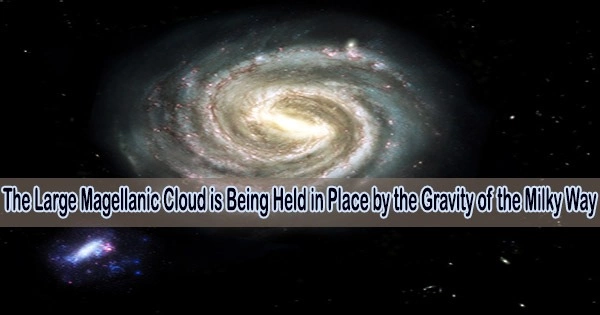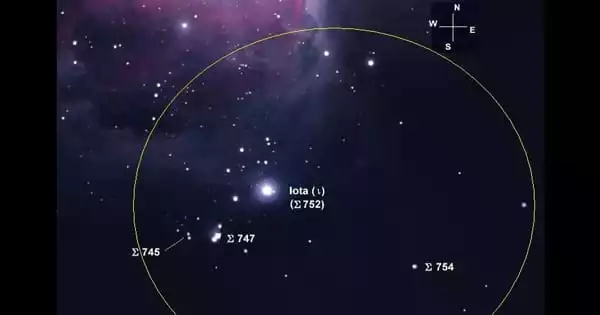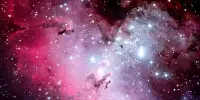The Large Magellanic Cloud (LMC), a dwarf galaxy observable with the unaided eye in the Southern Hemisphere, is the greatest nearest partner of our galaxy. Recent years have seen astronomers learn a lot about our (not-so-little) neighbor thanks to new theoretical research and improved observational capabilities. It’s becoming increasingly clear that the LMC is helping shape the Milky Way’s evolution.
“It was long assumed that our galaxy lives a quiet life of a hermit, with the nearest ‘big’ neighbor being Andromeda some 800 kiloparsecs away,” says Eugene Vasiliev of the University of Cambridge. “But with the growing realization that the LMC is rather massive, and because of a peculiar ‘historical moment’ (it just passed near the pericenter of its orbit, where its velocity and the reciprocal effect it imparts on the Milky Way are highest), we can no longer ignore the perturbations to our galaxy that it causes.”
The LMC is significant because it has a mass that ranges from 10% to 20% that of our own galaxy. It is thought to be in its first orbit around the Milky Way, according to astronomers. It was a spiral galaxy on its own before that orbit started. Its spiral arms were deformed by the Milky Way, yet a sturdy center bar remains as a reminder of its former shape.
The Milky Way, too, was changed by the interaction. For instance, the orbits of the stars and stellar streams closest to the LMC were deflected, and the Milky Way underwent more significant structural alterations.
Parts of the Milky Way that were closer to the LMC were more impacted than those that were farther away because the galaxy isn’t rigid but is instead made up of stars, dust, gas, and rock of different densities. The galaxy’s shape ultimately underwent a minor but significant deformation, particularly in its outer parts.
Astronomers should be able to see evidence of these changes, but it isn’t an easy task. Because we can’t capture a picture of the complete Milky Way like we can of a distant galaxy, it is challenging to examine the form of our home galaxy.
It was long assumed that our galaxy lives a quiet life of a hermit, with the nearest ‘big’ neighbor being Andromeda some 800 kiloparsecs away. But with the growing realization that the LMC is rather massive, and because of a peculiar ‘historical moment’ (it just passed near the pericenter of its orbit, where its velocity and the reciprocal effect it imparts on the Milky Way are highest), we can no longer ignore the perturbations to our galaxy that it causes.
Eugene Vasiliev
“Living inside our own galaxy is indeed a boon and a bane for an astrophysicist,” Vasiliev told Universe Today. “On the one hand, we can measure 3D positions and velocities for millions of stars with high precision, thanks to the Gaia astrometric satellite and numerous complementary ground-based spectroscopic surveys.” That’s something we can only dream of doing with distant galaxies, where we have “no information about the distribution of stars along the line of sight.”
On the other side, the Milky Way obscures much of what we can see of it because interstellar dust in the galaxy’s dense areas blocks light and obscures data. Furthermore, reliable position and velocity surveys like Gaia cannot be performed in the farthest regions of the galaxy due to their great distance.
In order to fill in the gaps, researchers must rely on models, which anticipate what will happen in the furthest reaches of the galaxy based on knowledge of the nearby regions.
But that makes it hard to see the effects of the LMC on the Milky Way clearly. Even a 5% overestimate of distances, for example, would affect our perception of the Milky Way and hide the LMC’s perturbations if there were a tiny modeling error.
The fact that it’s difficult doesn’t mean astronomers are giving up. The LMC’s size and proximity mean that its perturbations on our home galaxy ought to be quite significant. But how to find them?
The most recent Gaia data, which revealed an odd ‘striped’ pattern in the position and velocity of stars in the Milky Way’s galactic halo, may hold some of the key to the solution. The galactic disk is surrounded by a spherical region called the halo, which has a far lower density of stars than the disk itself.
These stripe patterns are believed to be the traces left behind by long-dead galaxies that merged with the Milky Way in the ancient past, like the hypothesized Gaia-Enceladus galaxy.
Astronomers like Vasiliev are looking for distortions in those stripes that should have been left by the LMC when it recently passed close to the Milky Way. The halo is the perfect place to look, because the region’s low density makes it more susceptible to changes caused by the LMC’s flyby than the inner regions of the galaxy are.
In fact, the galactic disk’s thick parts and our solar system are relatively shielded from the LMC’s aberrations. These areas of the Milky Way are compact, so when the LMC passed by, every star was shifted by the same amount. It wouldn’t have left behind any visible distortion.
Vasiliev says it helps to think of the LMC’s tug on the Milky Way in the same way we think of the Moon’s tug on Earth: “An isolated lake does not have tides,” he explains, “but the entire ocean does because the Moon’s gravitational force varies across its spatial extent.”
In the same way, we are unlikely to see LMC distortions in our local neighborhood, but across the vast galactic halo, the effects become much more obvious.
“The further out we go, the more important the differential shifts become,” says Vasiliev.
In April, Vasiliev published a review of the current state of knowledge about the LMC’s effects on the Milky Way. in the journal Galaxies. Despite recent advancements, there is still plenty to learn, and the new Gaia data is opening the door for more accurate models.
As for the future of the Milky Way and the LMC, they are, ultimately, on a collision course. The LMC will merge with the Milky Way in a few billion years, delivering more mass and metallicity to the Milky Way’s halo.
Of course, this dramatic event will be only a precursor to the even larger merger in store for the Milky Way, as the Andromeda galaxy will, at that point, be on its final approach towards us.
If there is a moral to this story, it’s that no galaxy is an island. Astronomers are working to take those influences into account as they examine our own galaxy, the Milky Way, because they are influencing its past, present, and future.
















